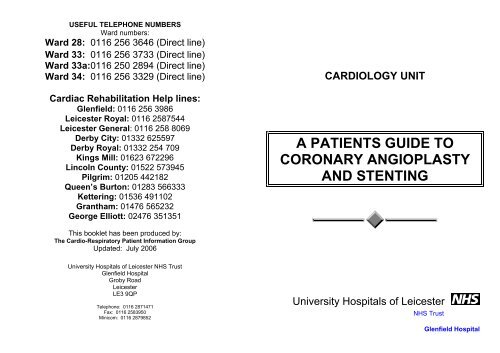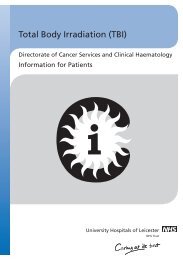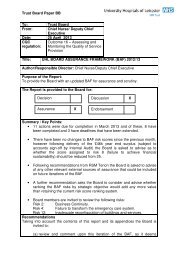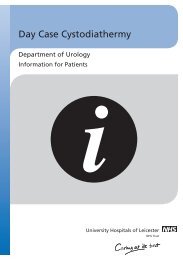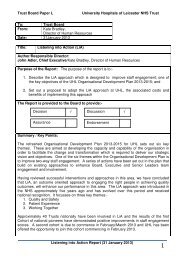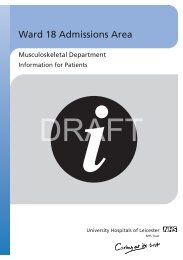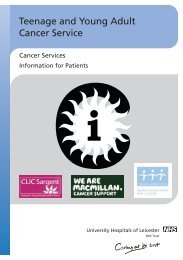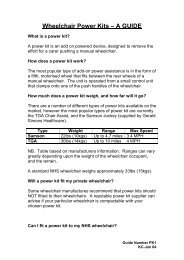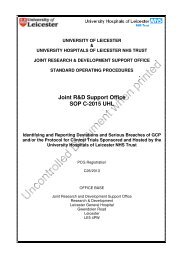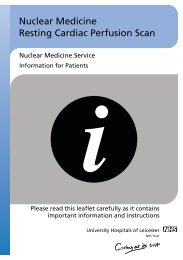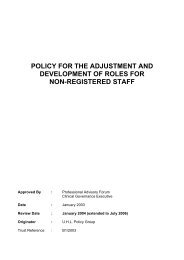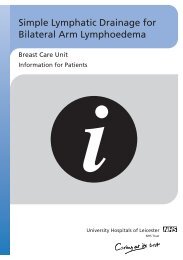Coronary Angioplasty and Stenting - Information for ... - Library
Coronary Angioplasty and Stenting - Information for ... - Library
Coronary Angioplasty and Stenting - Information for ... - Library
You also want an ePaper? Increase the reach of your titles
YUMPU automatically turns print PDFs into web optimized ePapers that Google loves.
USEFUL TELEPHONE NUMBERSWard numbers:Ward 28: 0116 256 3646 (Direct line)Ward 33: 0116 256 3733 (Direct line)Ward 33a:0116 250 2894 (Direct line)Ward 34: 0116 256 3329 (Direct line)Cardiac Rehabilitation Help lines:Glenfield: 0116 256 3986Leicester Royal: 0116 2587544Leicester General: 0116 258 8069Derby City: 01332 625597Derby Royal: 01332 254 709Kings Mill: 01623 672296Lincoln County: 01522 573945Pilgrim: 01205 442182Queen’s Burton: 01283 566333Kettering: 01536 491102Grantham: 01476 565232George Elliott: 02476 351351CARDIOLOGY UNITA PATIENTS GUIDE TOCORONARY ANGIOPLASTYAND STENTINGThis booklet has been produced by:The Cardio-Respiratory Patient <strong>In<strong>for</strong>mation</strong> GroupUpdated: July 2006University Hospitals of Leicester NHS TrustGlenfield HospitalGroby RoadLeicesterLE3 9QPTelephone: 0116 2871471Fax: 0116 2583950Minicom: 0116 2879852University Hospitals of LeicesterNHS TrustGlenfield Hospital
YOUR WOUNDLeave your dressing or your plaster on <strong>for</strong> 2 days after yourprocedure <strong>and</strong> then remove it <strong>and</strong> leave the puncture site exposedto heal. Some bruising <strong>and</strong> discolouration may develop at the sitebut it is not serious. Paracetamol can be taken <strong>for</strong> minordiscom<strong>for</strong>t. However, if at any stage you are concerned about yourwound site, may be it is very swollen or has an enlarging painfulbruise over it, please contact either your GP or the ward you stayed<strong>for</strong> advice.WHAT ABOUT MEDICATION FOR STENT IMPLANT?You will be prescribed a medicine called Clopidogrel, which stopsblood cells (platelets) sticking together on the stent implanted inyour coronary artery. You will be given specific instructions <strong>for</strong>how long you will need to take this <strong>for</strong>. The hospital pharmacy willprovide you with a supply <strong>for</strong> 1 month, so you will need to get arepeat prescription from your GP if you are required to take it <strong>for</strong>longer. Your doctor, nurse or pharmacist on the ward will adviseyou. You will need to continue to take aspirin as you have beendoing.INTRODUCTIONThis booklet has been developed to help you underst<strong>and</strong> what toexpect be<strong>for</strong>e, during <strong>and</strong> after your coronary angioplasty <strong>and</strong>stent implant. If you have any questions that the booklet does notanswer, please do not hesitate to ask the nursing or medical staffwho are looking after you.CORONARY ARTERY DISEASE<strong>Coronary</strong> artery disease is the term used to describe furring <strong>and</strong>narrowing of the arteries (blood vessels) in the heart that provideblood flow to the heart muscle. The gradual build up of fattymaterials in the inner lining of the arteries is the most commoncause of narrowing of the coronary arteries. Angina is the namegiven to the symptoms that happen when the build up is enough torestrict the blood flow down the artery <strong>and</strong> there<strong>for</strong>e the heartmuscle does not receive enough blood <strong>and</strong> oxygen. Thesesymptoms may include chest pain or discom<strong>for</strong>t as well asbreathlessness.Diagram of the Heart:ON DISCHARGEWhen you return home which should be within 1 or 2 daysfollowing your procedure, you should take it easy <strong>for</strong> at least 2days <strong>and</strong> slowly increase your activity. Ask your doctor or nurseabout returning to work as this often depends on your occupation,but the general rule is that we advise you to remain off work <strong>for</strong> 1week. Avoid lifting heavy objects <strong>and</strong> activities such as hoovering,mowing <strong>and</strong> lifting heavy shopping <strong>for</strong> 2 days <strong>and</strong> then return tonormal activity, as you feel able. <strong>In<strong>for</strong>mation</strong> is available on theward on lifestyle adjustment or through your local CardiacRehabilitation team.-9--2-
RISKSWhenever a procedure is per<strong>for</strong>med particularlyone involving the heart, there are risks involved.Thankfully, the risks <strong>for</strong> this procedure are small, but never theless important.There is a chance that the balloon <strong>and</strong> stent may damage theinside of the heart artery, causing it to tear or block; this maycause a heart attack. The chance of this occurring is about 1 or2% (1-2 in 100). In about 0.3% (1 in 300) of people, they need totreat this with an emergency bypass operation. These are seriousproblems <strong>and</strong> we know that some people do not survive thesesorts of complications, about 0.5% of all patients (1in 200). Tohelp prevent this, medication is given to you be<strong>for</strong>e <strong>and</strong> during theprocedure.There is a small chance about 2% (1-2 in 100) that you mightdevelop a complication with the site of the procedure in the groin.This usually amounts to bruising which will resolve with rest. In asmall number of cases a minor operation is required if a largerbruise with a collection of blood (haematoma) occurs.In the first 3 months after your procedure there is a chance thatthe artery may re narrow or even block, again medication likeaspirin <strong>and</strong> clopidogrel will help prevent this. This occurs in about15% of cases. As technology improves, there are newer stentswhich have reduced the risk of re narrowing to only about 5% ofpatients with even fewer needing a further stent. These new stentsare called drug eluting or drug releasing stents.The radiation risk from the X-rays used during coronaryangioplasty is equivalent to four years of background radiation(radiation that is normally found in the atmosphere) which ispresent in everyday life.- 7 -Several inflations <strong>and</strong> possibly more than 1 stent may benecessary to gradually widen the narrowing to achieve asatisfactory result.Once the required result has been achieved, the balloon is deflated<strong>and</strong> removed along with the guide catheter <strong>and</strong> wire, leaving awider artery with improvement of the blood flow to the heart muscle.The stent remains in place <strong>and</strong> can not be removed or move of itsown accord. Over time the stent becomes part of the artery wall.Following the insertion of a stent a thin film of cells grows over <strong>and</strong>lines the surface of the stent. This process is completed between 1month <strong>and</strong> 6 months depending on the type of stent used. Until thistime there is a risk of blood clotting which may occur on the surfaceof the stent <strong>and</strong> there<strong>for</strong>e block the coronary artery. This wouldcause you to experience chest pain <strong>and</strong> risk of a heart attack. Thisrisk can be significantly reduced by medicines such as Aspirin <strong>and</strong>Clopidogrel. These will be explained a little later in this booklet.ON ADMISSIONMany patients are seen in a pre admission clinic be<strong>for</strong>e beingadmitted to hospital <strong>for</strong> their procedure. If you are on warfarin orhave diabetes the doctor <strong>and</strong> nursing staff will advise you aboutwhat tablets you may need to stop be<strong>for</strong>e coming in to hospital.Remember to bring all your usual medication with you to your preadmission clinic <strong>and</strong> your admission.You will be admitted to either ward 34, 28, 33 or 33a. Onadmission you will be in<strong>for</strong>med of when you are scheduled <strong>for</strong>your procedure, which may be the following day if further bloodtests or X-rays are required. If you are well after the procedure<strong>and</strong> following discussions with you, we may discharge you homethe same day or ask you to remain in hospital <strong>for</strong> a night.-4-
PREPARATIONOn admission, the nurse looking after you will be able to adviseyou of what time you need to starve from <strong>and</strong> when you must stopdrinking from. This depends on when you will be having yourprocedure. On the morning of your procedure your nurse will askyou to have a shower or a bath. Be<strong>for</strong>e coming into hospitalplease shave the hair in your groin about an inch at both sides, asthis is where the tube is passed into the blood vessel under localanaesthetic. If you are unable or unsure about doing this, it canbe done in hospital.In case medication <strong>and</strong> fluids are needed to be given during theprocedure, a small plastic tube (called a venflon or cannula) willbe placed in the back of your h<strong>and</strong> or arm. A gown <strong>and</strong> pants willbe provided <strong>for</strong> you to wear during your procedure. About an hourbe<strong>for</strong>e you go <strong>for</strong> your angioplasty or stent implant you may begiven the opportunity to have a “pre medication” ofeither a tablet or an injection to help you relax.These are not routinely used but you can ask <strong>for</strong>this if you feel particularly anxious.The procedure is per<strong>for</strong>med away from the ward inone of the catheter rooms (labs). The lab containsthe specialised X-ray <strong>and</strong> monitoring equipmentrequired <strong>for</strong> the procedure. The staff in thedepartment wear gowns <strong>and</strong> gloves, as this is aclean procedure.DURING THE ANGIOPLASTY / STENT IMPLANTIf you have previously had a cardiac catheter you will find there isreally very little difference in what to expect during the procedure.bed onto the X-ray table, which is narrow, firm <strong>and</strong> moves up <strong>and</strong>down as required. Heart monitoring (ECG) leads will be attachedto your arms <strong>and</strong> legs. Your groin or wrist will be cleaned by anantiseptic lotion <strong>and</strong> covered with sterile towels.A local anaesthetic will be injected to numb the skin around thearea where the tube be inserted. You should feel no pain apartfrom the initial sting of the local anaesthetic. Once the guide wirehas been passed through the artery in the groin orwrist, you will not feel it as it is passed up to your heart.With the help of a dye, X-rays <strong>and</strong> a television screenthe narrowing in the artery is seen. The X-rayequipment will be brought close to your chest to allowthe balloon catheter to be positioned. You will beasked to rest your arms above your head during partsof the procedure so they do not get in the way of theX-ray machine.Whilst the balloon is being inflated in the coronary artery, you mayexperience your usual angina symptoms which you should in<strong>for</strong>mthe doctor of straightaway. This is due to the balloon causing atemporary blockage of blood flow through the artery <strong>and</strong> is to beexpected.The procedure may take 30 minutes or longer depending on thecomplexity <strong>and</strong> number of the narrowings in your coronary arteries.If more than one coronary artery requires treatment, each may betreated during the one procedure or on separate occasions.The sheath inserted in the groin or wrist to allow the catheter to bepassed to the heart, will be removed at the end of the procedure.Sometimes the sheath in the groin may need to remain <strong>for</strong> a fewhours after or sometimes until the following morning. Sometimesa ‘Closure Device’ is used to seal the entrance hole in the artery.On arrival at the catheter room, you will be transferred from your-5--6-


